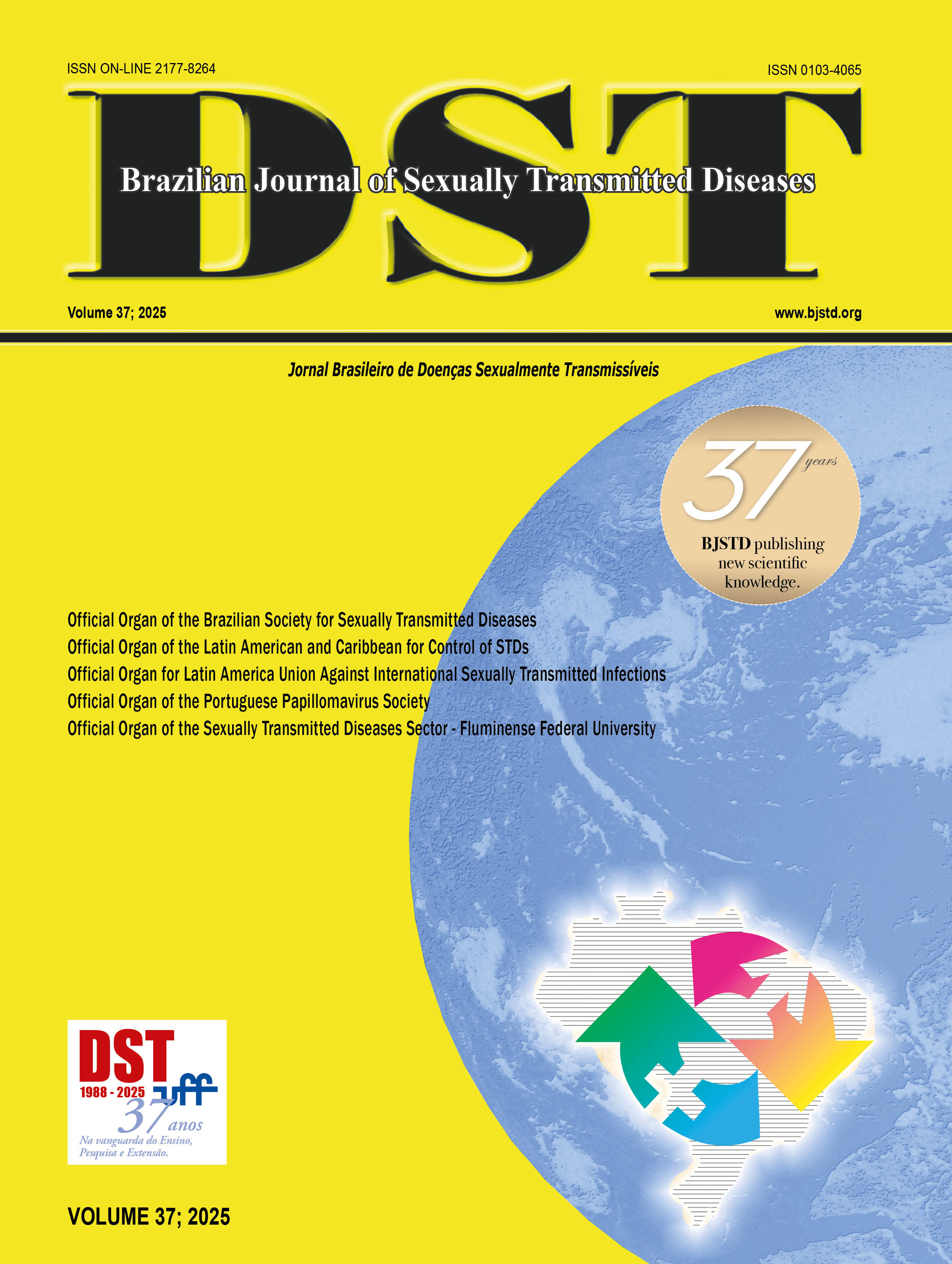Prevalence of condom use among men who have sex with men and using HIV pre-exposure prophylaxis
Prevalence of condom use in MSM which use PrEP
DOI:
https://doi.org/10.5327/DST-2177-8264-2025371437Keywords:
Sexual and gender minorities, Pre-exposure prophylaxis, Sexually transmitted diseasesAbstract
Introduction: Sexually transmitted infections (STIs) remain a critical global public health issue. Pre-exposure prophylaxis (PrEP), which involves the daily use of tenofovir and emtricitabine, has proven highly effective in preventing HIV transmission, especially among high-risk groups like men who have sex with men (MSM). However, PrEP usage may unintentionally reduce condom use, potentially increasing the risk of acquiring other STIs. Objective: The aim of this study was to describe the percentage of MSM who use PrEP and use condoms in their sexual activities. Methods: A cross-sectional, with a qualitative and descriptive approach, study was conducted using self-made questionnaires about PrEP usage among MSM. Data collection occurred via social media from October 2021 to May 2022, targeting 154 men aged 18–50 from Bauru, São Paulo, and its surroundings. Results: Of the 154 participants, 86.4% were aware of PrEP, but only 11.03% had ever used it, while 73.37% expressed willingness to use it. Among PrEP users, 5.84% reported contracting an STI during use, with gonorrhea and syphilis being the most common. Condom use was inconsistent across all groups, with only 3.24% of PrEP users and 32.46% of potential users consistently using condoms in all sexual encounters. The findings highlight significant gaps in PrEP usage and condom adherence, emphasizing the need for targeted interventions to address STI prevention and promote consistent condom use. Conclusion: Although PrEP is effective in preventing HIV, this study highlights its association with risky sexual behaviors, leading to higher STI rates. Comprehensive education is essential to mitigate these risks.
Downloads
References
Miranda AE, Gaspar PC, Schörner MA, Barazzetti FH, Dias GB, Bigolin A, et al. Prevalence of chlamydia trachomatis, neisseria gonorrhoeae, trichomonas vaginalis, and mycoplasma genitalium and risk factors among pregnant women in Brazil: results from the national molecular diagnosis implementation project. Int J Gynaecol Obstet. 2024;166(1):71-9. https://doi.org/10.1002/ijgo.15447
Brasil. Ministério da Saúde. Secretaria de Vigilância em Saúde e Ambiente. Boletim Epidemiológico de Sífilis 2024 [Internet]. Brasília: Ministério da Saúde; 2024 [cited 2024 Oct. 26]. Available from: https://www.gov.br/aids/pt-br/central-de-conteudo/boletins-epidemiologicos/2024/boletim_sifilis_2024_e.pdf/view
Brasil. Ministério da Saúde. Secretaria de Vigilância em Saúde e Ambiente. Boletim Epidemiológico HIV/Aids 2024 [Internet]. Brasília: Ministério da Saúde; 2024 [cited 2024 Oct. 26]. Available from: https://www.gov.br/aids/pt-br/central-de-conteudo/boletins-epidemiologicos/2024/boletim_hiv_aids_2024e.pdf/view
Yeganeh N, Kreitchmann R, Leng M, Nielsen-Saines K, Gorbach PM, Klausner J. High prevalence of sexually transmitted infections in pregnant women living in southern Brazil. Sex Transm Dis. 2021;48(2):128-33. https://doi.org/10.1097/OLQ.0000000000001276
Ferreira-Júnior ODC, Guimarães MDC, Damacena GN, Almeida WS, Souza-Júnior PRB, Szwarcwald CL, et al. Prevalence estimates of HIV, syphilis, hepatitis B and C among female sex workers (FSW) in Brazil, 2016. Medicine (Baltimore). 2018;97(1S Suppl 1):S3-S8. https://doi.org/10.1097/MD.0000000000009218
Kops NL, Bessel M, Horvath JDC, Domingues C, Souza FMA, Benzaken AS, et al. Factors associated with HPV and other self-reported STI coinfections among sexually active brazilian young adults: cross-sectional nationwide study. BMJ Open. 2019;9(6):e027438. https://doi.org/10.1136/bmjopen-2018-027438
Bomfim IG, Dos Santos SD, Ruggiero CM, Napoleão AA. Factors associated with sexually transmitted infection/hiv diagnosis among a predominantly university population in Brazil. Int J STD AIDS. 2021;32(9):821-9. https://doi.org/10.1177/0956462421997251
Traeger MW, Schroeder SE, Wright EJ, Hellard ME, Cornelisse VJ, Doyle JS, et al. Effects of pre-exposure prophylaxis for the prevention of human immunodeficiency virus infection on sexual risk behavior in men who have sex with men: a systematic review and meta-analysis. Clin Infect Dis. 2018;67(5):676-86. https://doi.org/10.1093/cid/ciy182
Ayerdi Aguirrebengoa O, Vera García M, Arias Ramírez D, Gil García N, Puerta López T, Clavo Escribano P, et al. Low use of condom and high STI incidence among men who have sex with men in PrEP programs. PLoS One. 2021;16(2):e0245925. https://doi.org/10.1371/journal.pone.0245925
Chen YH, Guigayoma J, McFarland W, Snowden JM, Raymond HF. Increases in pre-exposure prophylaxis use and decreases in condom use: behavioral patterns among hiv-negative San Francisco men who have sex with men, 2004-2017. AIDS Behav. 2019; 23(7):1841-5. https://doi.org/10.1007/s10461-018-2299-7
Marcus U, Schink S, Weber C. HIV pre-exposure prophylaxis and diagnoses of sexually transmitted infections – observational data from German checkpoints, 01/2019–08/2021. BMC Public Health. 2023;23(1):661. https://doi.org/10.1186/s12889-023-15570-6
van den Elshout MAM, Wijstma ES, Boyd A, Jongen VW, Coyer L, Anderson PL, et al. Sexual behaviour and incidence of sexually transmitted infections among men who have sex with men (MSM) using daily and event-driven pre-exposure prophylaxis (PrEP): four-year follow-up of the Amsterdam PrEP (AMPrEP) demonstration project cohort. PLoS Med. 2024;21(5):e1004328. https://doi.org/10.1371/journal.pmed.1004328
Brasil. Ministério da Saúde. Protocolo clínico e diretrizes terapêuticas para profilaxia pré-exposição (PrEP) de risco à infecção pelo HIV [Internet]. Brasília: Ministério da Saúde; 2022 [cited 2024 Ago. 01]. Available from: https://www.gov.br/aids/pt-br/centrais-de-conteudo/publicacoes/2022/protocolo-clinico-e-diretrizes-terapeuticas-para-profilaxia-pre-exposicao-prep-2022.pdf
Brasil. Ministério da Saúde. Secretaria de Vigilância em Saúde. Departamento de Vigilância, Prevenção e Controle das Infecções Sexualmente Transmissíveis, do HIV/Aids e das Hepatites Virais. Prevenção combinada do HIV: bases conceituais para profissionais, trabalhadores(as) e gestores(as) de saúde [Internet]. Brasília: Ministério da Saúde; 2017 [cited 2023 Dec. 15]. Available from: https://www.gov.br/aids/pt-br/centrais-de-conteudo/publicacoes/2017/prevencao_combinada_-_bases_conceituais_web.pdf
Brasil. Ministério da Saúde. Secretaria de Vigilância em Saúde. Departamento de DST, Aids e Hepatites Virais. Pesquisa de conhecimento, atitudes e práticas na população brasileira [Internet]. Brasília: Ministério da Saúde; 2016 [cited 2024 July 11]. Available from: https://www.gov.br/aids/pt-br
Silva MST, Torres TS, Coutinho C, Moreira RI, Leite IC, Cunha M, et al. Bacterial sexually transmitted infections among men who have sex with men and transgender women using oral pre-exposure prophylaxis in Latin America (ImPrEP): a secondary analysis of a prospective, open-label, multicentre study. Lancet HIV. 2024;11(10):e670-9. https://doi.org/10.1016/S2352-3018(24)00211-X
Published
How to Cite
Issue
Section
License
Copyright (c) 2024 Brazilian Journal of Sexually Transmitted Diseases

This work is licensed under a Creative Commons Attribution 4.0 International License.












